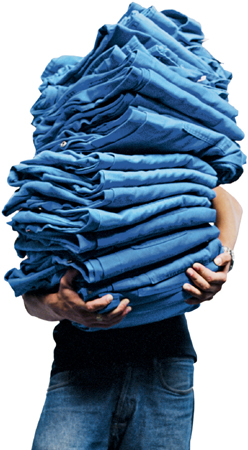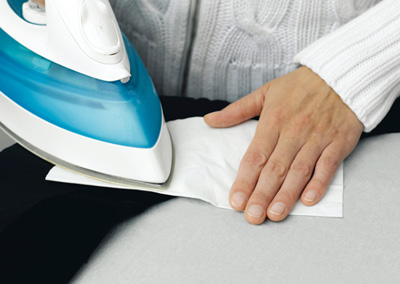
Nowadays, the twist of a knob is all it takes to get clean clothes. But back in the days when doing the laundry was an eight-hour ordeal, there were some helpful tricks—some of which are still useful for saving energy and protecting the environment.
WASH WORK CLOTHES SEPARATELY.
We all like to keep our whites clean and bright, but laundry products such as bleach contain harsh ingredients that are tough on lungs and the planet. Traditional methods will let you keep your laundry room bleach-free and provide the special care required for coloreds, wool, lace, velvet and silk.
• Let your whites soak in a basin of hot water and lemon slices (tied in muslin) for 1–2 hours, then wash as usual. If clothes are particularly dingy, boil the water, turn off the heat, add your clothing and lemon slices and soak overnight.
• White vinegar works well, too. Pour 1/2–1 cup (125–250 ml) into the wash with the detergent. It will whiten, help to wash away detergent or soap residue and soften the fabric.
• One more idea: The old-fashioned power of sunlight helps to brighten whites and gives them that wonderful fresh outdoor scent.
You can get your washing beautifully clean in an environmentally friendly way with an energy-efficient washing machine using the following ground rules.
• Do not add too much detergent and never use more than the manufacturer recommends, as this will result in a soap overflow.
• Take water hardness into account–the softer the water, the less detergent you need.
• Choose the appropriate washing program so the water level matches the laundry load. This protects the machine, especially during the spin cycle.
• Avoid the prewash cycle, which is unnecessary for most laundry.
• Soak yellowed or graying laundry in a natural bleach (see above).
• Put delicate articles into a cloth bag or an old pillowcase before washing.
• Before washing, close zippers and rub them with graphite or a little grease so that they don’t jam later on. Also, undo buttons and turn pockets inside out.
• The collars and cuffs of shirts and blouses don’t always come out of the wash clean. Before washing them, use a nailbrush to apply a little shampoo formulated for greasy hair or some liquid detergent. Leave for 15 minutes before washing in the washing machine at the hottest possible setting. For a quick treatment, wash the collar only, by hand, rinse well, rub as dry as possible in a thick towel, and iron dry.
• If possible, remove stains before doing the laundry.
• Soak very dirty laundry overnight in soapy water before washing. Make use of oxygen bleach powder and modern stain removers.
Cleaning velvet
1 Grate pieces of chalk and sprinkle the powder on an absorbent paper towel. Fold the chalk into the paper.

2 Place the paper towel on the velvet and go over it with the iron to draw out the grease.
• These can be pricey, so consider a natural softener. Add 1 tablespoon (15 ml) salt to the last rinse, or pour 1 cup (250 ml) vinegar into the last rinse cycle.
• Add 1/2 cup (125 ml) baking soda to the main wash cycle. It will make your white wash whiter and give it a fresh smell.
• Soak discolored white laundry in fresh milk until it turns sour, then rinse and wash as usual.
• Use dishwasher detergent in your laundry loads instead of laundry detergent. However, this can be hard on clothes, so use it only on heavy-duty clothing, sheets and towels.
Always check the color fastness of new fabrics. To do this, wet the fabric and rub it with white paper. If any dye comes off on the paper, hand wash the item with soft soap. Follow these tips to keep coloreds looking their best.
• Prevent new colored fabrics from running by adding a dash of vinegar to the wash water.
• Add sugar to the rinse water so colored laundry comes out bright.
• Never hang colored laundry to dry in bright sunlight, as the colors will fade.
• Protect jeans from wear before washing them by soaking them in a salt solution–1 tablespoon (15 ml) salt in 1 quart (1 L) water.
• Do not starch colored laundry when it is still hot, or the colors may run.
• Hand wash blouses and pillowcases made from natural silk with a special wool or silk detergent, rinse thoroughly and hang up dripping wet to dry.
• Allow black silk to retain its shine by washing it with black tea and a little mild detergent.
• Washable velvet will shine after being laundered if you brush it down with a little salt.
• Wash raw silk by swishing it around in warm, soapy water before rolling the garment in a towel to extract as much of the water as possible. Lay it flat to dry and iron on the reverse side while still damp.
• To banish sweat odors, moisten two cloths with a weak water and ammonia solution, place the article of clothing between them and steam it with the iron.
• Woolens stay soft if you add a few drops of vinegar to the next-to-last rinse and a similar quantity of glycerin to the final rinse.
• Shampoo is excellent for cleaning wool and preventing it from becoming matted.
• Soften a scratchy sweater with 1 tablespoon (15 ml) hair conditioner in a sink of water. Swish the item around for 2 minutes, rinse and dry.
• Spinning wool items can cause them to lose their shape. Roll them gently in a dry towel, squeeze out excess water and dry flat.